Nestled on the scenic coast of County Donegal, Bundoran has a rich and varied history that spans centuries. From its humble beginnings as two separate villages to its current status as one of Ireland’s premier seaside resorts, Bundoran’s story is one of transformation and resilience. This charming town has weathered significant changes in Ireland’s social, economic, and political landscape, continually adapting to meet the needs of both its residents and visitors. Known today as the “Surf Capital of Ireland” and a popular destination for families and adventure seekers alike, Bundoran’s journey from a quiet coastal settlement to a bustling tourist hub reflects the broader evolution of Irish tourism and culture. This article explores the key events, developments, and cultural elements that have shaped Bundoran into the vibrant community it is today, offering insights into its past and glimpses of its potential future.
Contents
Early Origins and Development
The origins of modern-day Bundoran can be traced back to two distinct villages that existed over a century ago. These settlements, which eventually merged to form the town we know today, were Single Street and Bundoran.
Single Street was located in the eastern part of what is now Bundoran, in the townland of Finner. This village was primarily inhabited by the local Catholic population and developed steadily throughout the early 19th century. It was where the majority of the native residents lived and formed the core of the local community.
Bundoran, on the other hand, was situated to the west of the River Bradoge bridge, in an area now known as the West End. This part of town was initially developed as a Protestant Ascendancy resort, attracting more affluent visitors and residents. The contrast between these two settlements was evident in their architecture and social composition.
Between these two villages lay the townland of Drumacrin, which would later become part of the town center as the two communities gradually expanded and merged.
The name “Bundoran” comes from the Irish “Bun Dobhráin,” which translates to “the foot of the little water.” This name is fitting given the town’s location at the mouth of the River Bradoge where it meets Donegal Bay. The “little water” in the name likely refers to this river, highlighting the importance of this waterway in the town’s geography and early development.
It wasn’t until the arrival of the railway in 1866 and the construction of Bundoran railway station that the two villages began to grow together. The railway station, named Bundoran, served as a focal point for development, gradually bridging the gap between Single Street and Bundoran. Over time, as transport links improved and tourism increased, the distinct identities of the two original settlements faded, giving rise to the unified town of Bundoran as we know it today.
This early division and subsequent merging of communities have left a lasting impact on Bundoran’s layout and character, with the East and West ends of the town still retaining some of their original distinctive features.
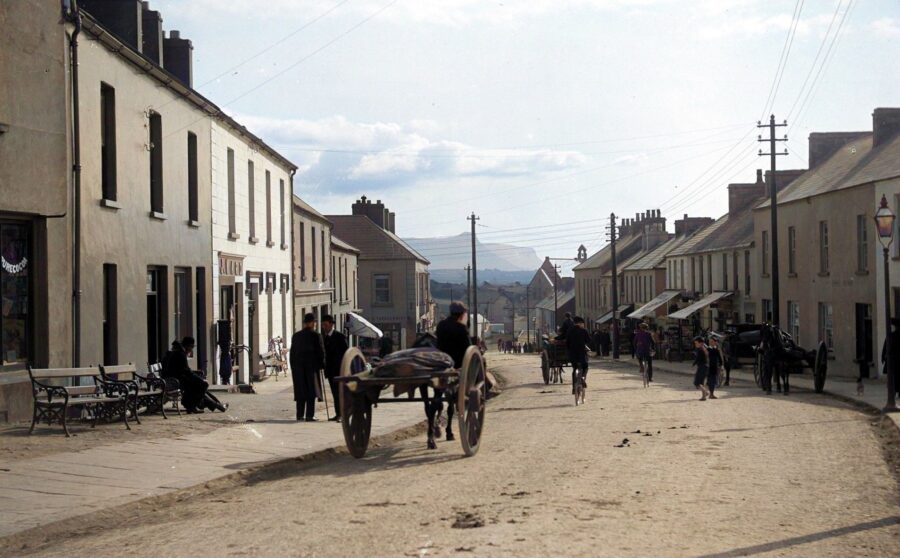
18th Century Beginnings
The 18th century marked the beginning of Bundoran’s transformation from a simple coastal settlement to a fashionable resort town. This change was largely initiated by the aristocracy, who began to recognize the area’s potential as a seaside retreat.
A pivotal moment in Bundoran’s history came in 1777 when William Cole, Viscount Enniskillen, built Bundoran Lodge. This summer residence, now known as Homefield House, still stands on Bayview Avenue and represents the first significant development of Bundoran as a leisure destination. The Viscount’s choice to build his summer home here was a testament to the area’s natural beauty and potential for relaxation.
Viscount Enniskillen’s decision to establish a presence in Bundoran set a trend among his peers in the Protestant Ascendancy. Following his lead, other wealthy individuals began to construct their own “Big Houses” in what is now the West End of Bundoran. Notable examples included Daneville Lodge, Rose Lodge (later called Dinglei Coush), and the Gore-Booth family’s holiday home, Seaview. These grand residences began to shape the landscape of Bundoran, particularly in the West End, giving it a distinctly affluent character.
The appeal of Bundoran to the upper classes was multifaceted. The beautiful coastal scenery, fresh sea air, and the perceived health benefits of sea bathing all contributed to its growing popularity. As more members of the Ascendancy discovered Bundoran, it gained a reputation as a fashionable holiday destination, sometimes referred to as the “Brighton of Ireland,” drawing comparisons to the popular English seaside resort.
This development as a resort for the affluent had a significant impact on the local economy and infrastructure. It led to the construction of new roads, the improvement of existing buildings, and the gradual development of services catering to wealthy visitors. The influx of affluent guests also brought new cultural influences to the area, setting the stage for Bundoran’s future growth as a diverse and popular tourist destination.
19th Century Growth
The 19th century was a period of significant transformation for Bundoran, marked by rapid development and the town’s emergence as a popular seaside resort accessible to a broader spectrum of society.
A crucial milestone in Bundoran’s growth was the arrival of the railway in 1866. The Enniskillen and Bundoran Railway (E&BR) connected Bundoran to Ireland’s expanding railway network, making the town far more accessible from major population centers like Belfast and Dublin. This improved connectivity was a game-changer for Bundoran’s tourism industry.
The railway’s arrival catalyzed the merging of the two previously separate villages – Single Street in the east and Bundoran in the west. The railway station, simply called “Bundoran,” was built in the Drumacrin townland between the two settlements. This central location encouraged development in the area, gradually filling the gap between the villages and leading to their eventual unification into the singular town of Bundoran.
With improved transportation links, Bundoran’s popularity as a seaside destination soared. The town began to attract visitors from all social classes, not just the affluent Ascendancy who had dominated in the previous century. The perceived health benefits of sea bathing, combined with the town’s natural beauty, made it an attractive destination for Victorian holidaymakers.
To accommodate the influx of visitors, numerous hotels and lodging houses sprang up around the town. The main street saw significant development, with businesses catering to tourists opening alongside the new accommodations. This period saw the construction of many of Bundoran’s iconic buildings, including:
- Brighton Terrace, built by the local Hamilton family in 1856
- Shell House, constructed around 1870
- The old AIB Bank (now Bundoran Community Centre) and The Railway Bar, both built around 1875
The crowning achievement of this era was the construction of the Great Northern Hotel by the Great Northern Railway (GNR), which had taken over operation of the E&BR line in 1876. The Great Northern Hotel quickly became one of Bundoran’s most recognizable landmarks and a symbol of its status as a premier resort town. Its grand architecture and prime location overlooking the sea epitomized the town’s transformation into a major tourist destination.
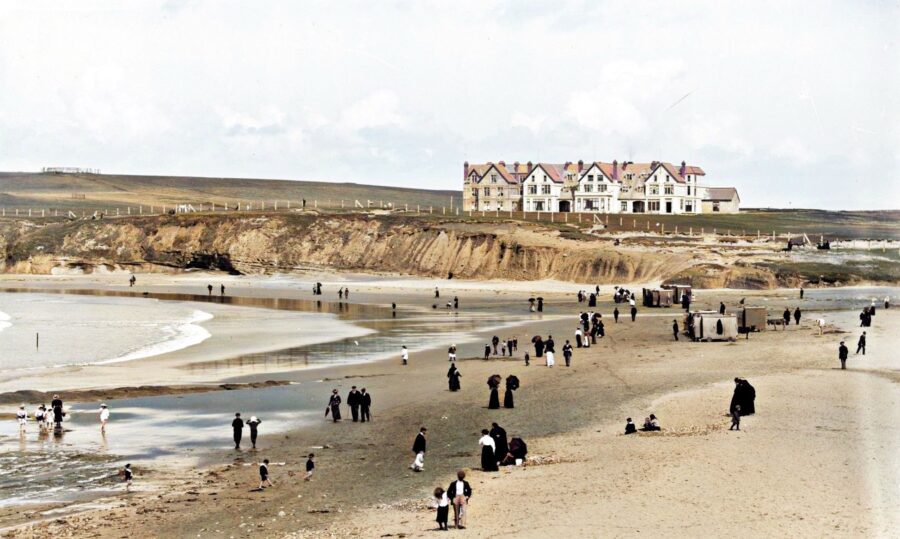
By the end of the 19th century, Bundoran had firmly established itself as one of Ireland’s most popular seaside resorts and one of the main holiday destinations in Ulster. The town’s growth during this period laid the foundation for its continued success as a tourist destination throughout the 20th century and beyond.
Religious and Cultural Development
The 19th century also saw significant religious and cultural development in Bundoran, reflecting the town’s growth and the diverse needs of its expanding population and visitors.
Religious institutions played a crucial role in the town’s development. In 1859, Bundoran’s Catholic Church was built under the direction of Reverend Francis Kelaghan. The construction was carried out by the local Gilroy brothers, demonstrating the community’s involvement in this significant project. This church became a central feature of the town, serving the needs of the local Catholic population as well as visiting worshippers.
The Church of Ireland community was also catered for with the construction of their church beside the bridge between 1839 and 1840. This church was designed by William Hagerty, who had also contributed to the design of St. Anne’s Church in nearby Ballyshannon. The presence of both Catholic and Protestant churches in the town reflected the mixed demographics of residents and visitors.
Other denominations also established places of worship in Bundoran during this period. The Old Methodist Church on Main Street was built in 1888, while the Presbyterian Church in the West End was constructed in 1865, although it is now derelict. These various churches not only served spiritual needs but also became important architectural landmarks in the town.
In terms of education and social welfare, the Sisters of St. Louis made a significant contribution by opening the St. Louis Convent and schools on Station Road (now Railway Road) in 1892. This institution played a crucial role in the education of local children for many years.
Bundoran also has associations with notable cultural figures. Perhaps the most famous is William Allingham, the 19th-century poet and diarist, who had close ties to the area. While Allingham was born in nearby Ballyshannon, his family had connections to Bundoran. The Allingham Arms Hotel in Bundoran is named after him, highlighting his cultural significance to the area.
The hotel itself has an interesting history. It was originally named Allingham Lodge in the 1840s by Florinda Allingham, a close relative of the poet. Florinda’s father, Edward Allingham, lived at Magheracar, further connecting the family to the Bundoran area.
William Allingham’s poetry often drew inspiration from the landscapes and people of Donegal, including Bundoran and its surroundings. His work helped to put the area on the cultural map, attracting interest from literary circles and potentially contributing to Bundoran’s appeal as a destination.
20th Century Tourism
Throughout the 20th century, Bundoran continued to flourish as a popular seaside resort, building on the foundations laid in the previous century. The town adapted to changing tastes and expectations, developing new amenities and attractions to keep visitors coming back year after year.
Bundoran’s popularity remained strong in the early to mid-20th century. The town benefited from improved transportation links, including better roads and bus services, which complemented the existing railway connection. During The Emergency (World War II), the Great Northern Railway introduced the Bundoran Express, linking Dublin and Bundoran via Dundalk and Enniskillen. This service, which also carried pilgrims to nearby Lough Derg, helped maintain a steady flow of visitors even during challenging times.
The town’s beaches remained a primary attraction. The tradition of bathing boxes, which began in Victorian times, continued into the 20th century. These boxes, initially mobile and later stationary, provided privacy for bathers and became a characteristic feature of the Bundoran beach experience. In the 1920s, enterprising locals like Mrs. Elizabeth Travers and Bilshie Travers hired out bathing costumes and towels, catering to the needs of day-trippers and holidaymakers.
New attractions were developed to entertain visitors. In the 1950s and 1960s, “The Duck,” a former British Army amphibious craft, became a popular feature, ferrying tourists out into Donegal Bay. Despite its tendency to break down, it remained a beloved attraction for many years.
The amusement industry also grew in Bundoran during this period. Amusement arcades, fairground rides, and other entertainment venues sprang up, catering to families and young people. These attractions helped to diversify Bundoran’s appeal beyond just its natural seaside charms.
Bundoran’s reputation as a music venue also began to develop in the 20th century. The Astoria Ballroom, built in 1953, became a major entertainment center, hosting popular showbands and large dances. It even attracted international acts, with Meatloaf performing there in 1990.
The latter part of the century saw further developments aimed at modernizing Bundoran’s tourism offering:
- In 1991, the Waterworld complex opened, providing an all-weather attraction that would prove crucial in extending the tourist season beyond the summer months.
- The town began to gain recognition as a surfing destination, with its consistent waves attracting surfers from across Ireland and beyond.
- Golf tourism also grew in importance, with the Bundoran Golf Club (founded in 1894) continuing to attract players to its scenic coastal course.
- The development of new hotels and the upgrading of existing ones helped to improve the quality of accommodation available to visitors.
Despite challenges, including the closure of the railway line in 1957 and changing holiday patterns, Bundoran successfully reinvented itself throughout the 20th century. By diversifying its attractions and amenities, the town maintained its status as one of Ireland’s premier seaside resorts, setting the stage for continued success in the 21st century.
Modern Bundoran
In recent decades, Bundoran has continued to evolve and adapt to changing tourism trends, solidifying its position as a leading Irish seaside resort while diversifying its offerings to attract a wider range of visitors.
Recent Developments:
The Waterworld complex, opened in 1991, has been a significant addition to Bundoran’s attractions. This indoor water park came about as a result of major storm damage along the seafront in 1988. It features a wave pool, rapids, and slides, with further expansions in 1994 and 2013 adding new attractions. Owned by Donegal County Council, Waterworld has become a crucial all-weather facility, helping to extend the tourist season beyond the traditional summer months.
In 2019, Bundoran was designated as Failte Ireland’s Destination Town for County Donegal. This status paved the way for a €500,000 investment from the national tourism development authority to enhance the town’s tourism infrastructure and appeal.
Accommodation and Tourism Infrastructure:
Bundoran boasts a diverse range of accommodation options to cater to various budgets and preferences. As of 2018, the town had:
- Several large hotels, including The Allingham Arms (132 rooms), The Great Northern (102 rooms), and The Holyrood (91 rooms)
- 16 caravan sites and campsites, providing 4,312 beds
- Several hundred self-catering residences
- 9 hostels
This extensive accommodation base makes Bundoran the largest in the northwest of Ireland, capable of hosting a significant number of visitors year-round.
Surfing and Other Recreational Activities:
One of the most significant developments in modern Bundoran has been its emergence as a premier surfing destination. Known as the “Surf Capital of Ireland,” Bundoran offers several popular surf spots including The Peak, Tullan Strand, and nearby Rossnowlagh beach. The town has hosted the European Surfing Championships twice (in 1985 and 2011) and is consistently rated as Ireland’s top beginner beach for surfing.
To support this growing aspect of tourism, Bundoran now hosts five International Surfing Association (ISA) approved surfing schools offering all-inclusive packages. This development has attracted a new demographic of visitors and helped to establish Bundoran as a year-round destination, as surfing conditions can be favorable even in cooler months.
Beyond surfing, modern Bundoran offers a wide array of recreational activities:
- Golf: The 18-hole Bundoran Golf Club, founded in 1894, continues to attract golfers with its challenging course and scenic views.
- Waterworld: Offering indoor water-based fun for all ages.
- Sea Sessions Surf and Music Festival: An annual event combining music and surfing, attracting thousands of visitors each June.
- Coastal walks: The development of scenic coastal paths has enhanced the town’s appeal for walkers and nature enthusiasts.
- Adventure activities: Facilities for activities such as horse riding, cycling, and water sports have expanded.
Bundoran has also maintained its traditional seaside attractions while adding modern amenities. The main beach continues to be a draw, having been awarded Blue Flag status consistently (except for 2019). Amusement arcades, such as Macks Amusements, combine traditional seaside entertainment with modern gaming machines.
In essence, modern Bundoran has successfully blended its traditional seaside charm with contemporary attractions and activities. By diversifying its offerings and improving its infrastructure, the town has maintained its appeal to long-time visitors while attracting new generations of tourists, ensuring its continued success as a vibrant Irish resort town.
Architectural Heritage
Bundoran’s architectural heritage reflects its unique history as a town that developed from two distinct settlements. The contrast between the East and West End architecture provides a visual narrative of the town’s social and economic evolution.
Contrast between East and West End architecture:
East End (formerly Single Street):
The East End, which grew from the original village of Single Street, showcases architecture typical of a traditional Irish rural settlement. This area was primarily inhabited by the local Catholic population and working-class residents. The architecture here is characterized by:
- Smaller, more modest dwellings
- Traditional Irish cottages
- Simple, functional designs
A prime example of this architectural style is the small thatched cottage formerly known as Sean O’Brien’s shop, built around 1830. This building epitomizes the type of dwelling common among locals in the 19th century East End.
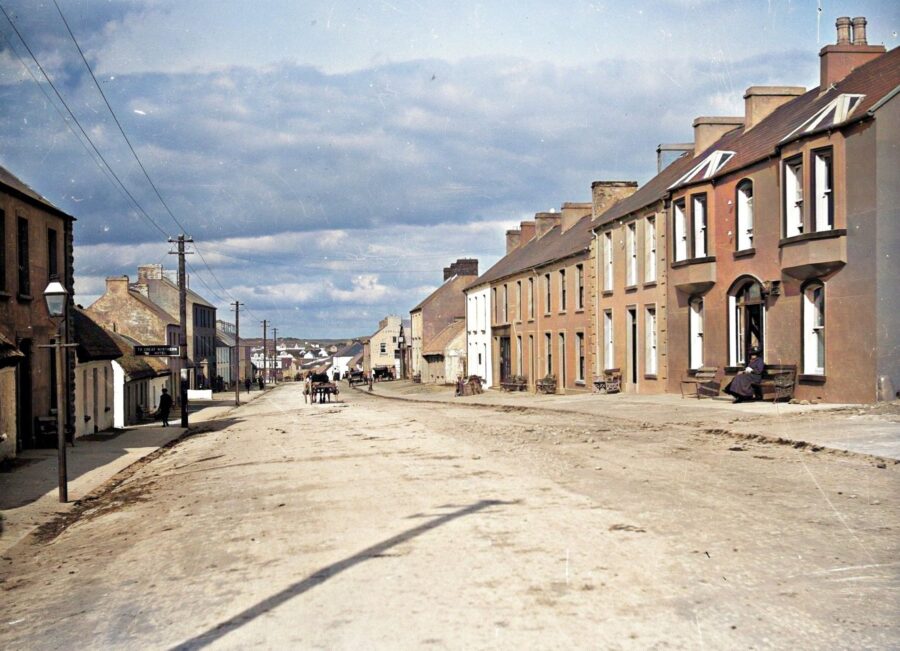
West End:
The West End, which developed as a Protestant Ascendancy resort, features more grandiose and elaborate architecture reflective of its wealthier residents and visitors. Characteristics of West End architecture include:
- Larger, more ornate buildings
- Victorian and Edwardian influences
- Grander hotels and guesthouses
The Ascendancy architecture is particularly evident in structures like Bay View Terrace, built between 1899 and 1912, and continues through to Rochfort Lodge at the tip of Magheracar.
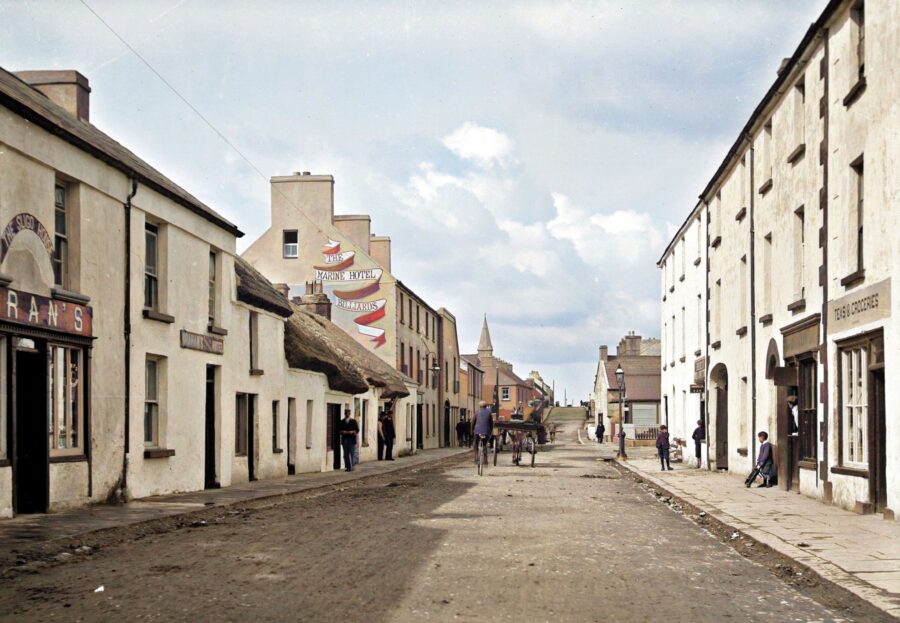
Notable buildings and landmarks:
- The Great Northern Hotel: Built by the Great Northern Railway Company, this is one of Bundoran’s most recognizable landmarks, embodying the grand hotel style of the late 19th century.
- Bundoran Catholic Church: Constructed in 1859 by the Gilroy brothers, this church represents a significant religious and architectural focal point in the town.
- Church of Ireland building: Built between 1839 and 1840 near the bridge, designed by William Hagerty.
- Old Methodist Church: Constructed on Main Street in 1888.
- Brighton Terrace: Built by the Hamilton family in 1856, this terrace is a fine example of mid-19th century residential architecture.
- The Pump House: Overlooking Donegal Bay, this structure was built by the Hamilton family in 1861 and stands as a reminder of the town’s Victorian-era infrastructure.
- Shell House: Built around 1870, this building is notable for its distinctive exterior adorned with shells and crockery mosaic, added around 1930.
- The old AIB Bank (now Bundoran Community Centre): Constructed around 1875, this building represents the commercial architecture of the late 19th century.
- Brennan’s Bar: Opened in 1900, this pub is known for its traditional interior, including a preserved “snug” area.
- St. Louis Convent: Built in 1892, this complex represents the educational architecture of the late 19th century.
- Homefield House (formerly Bundoran Lodge): Built in 1777 by Viscount Enniskillen, this is one of the oldest surviving buildings in Bundoran and marks the beginning of its development as a resort town.
These buildings and the contrast between the East and West End architecture not only provide aesthetic interest but also serve as tangible links to Bundoran’s rich history. They tell the story of the town’s evolution from two separate villages into a unified, thriving seaside resort, reflecting the social, economic, and cultural changes that have shaped Bundoran over the centuries.
Transportation and Connectivity
The development of transportation infrastructure has played a crucial role in Bundoran’s growth and success as a seaside resort. The improvements in connectivity, particularly through railway and road developments, have significantly impacted the town’s accessibility and popularity.
Impact of the railway:
The arrival of the railway in 1866 marked a turning point in Bundoran’s history. The Enniskillen and Bundoran Railway (E&BR) connected the town to Ireland’s growing railway network, making it more accessible to a wider population. Key impacts included:
- Increased visitor numbers: The railway made it easier for people from Belfast, Dublin, and other urban centers to visit Bundoran, leading to a surge in tourism.
- Town unification: The railway station, situated between the villages of Single Street and Bundoran, acted as a catalyst for the merging of these two settlements into one town.
- Economic growth: Improved connectivity led to increased trade and commerce, spurring the development of hotels, guesthouses, and other tourism-related businesses.
- Extended tourist season: The ease of travel allowed for shorter visits and weekend trips, helping to extend the tourist season beyond the traditional summer months.
- Cultural exchange: The railway brought diverse visitors from different parts of Ireland, contributing to cultural exchange and broadening Bundoran’s appeal.
The Great Northern Railway (GNR) took over the operation of the E&BR line in 1876, further improving services. During The Emergency (World War II), the GNR introduced the Bundoran Express, which linked Dublin and Bundoran via Dundalk and Enniskillen, maintaining vital connections during challenging times.
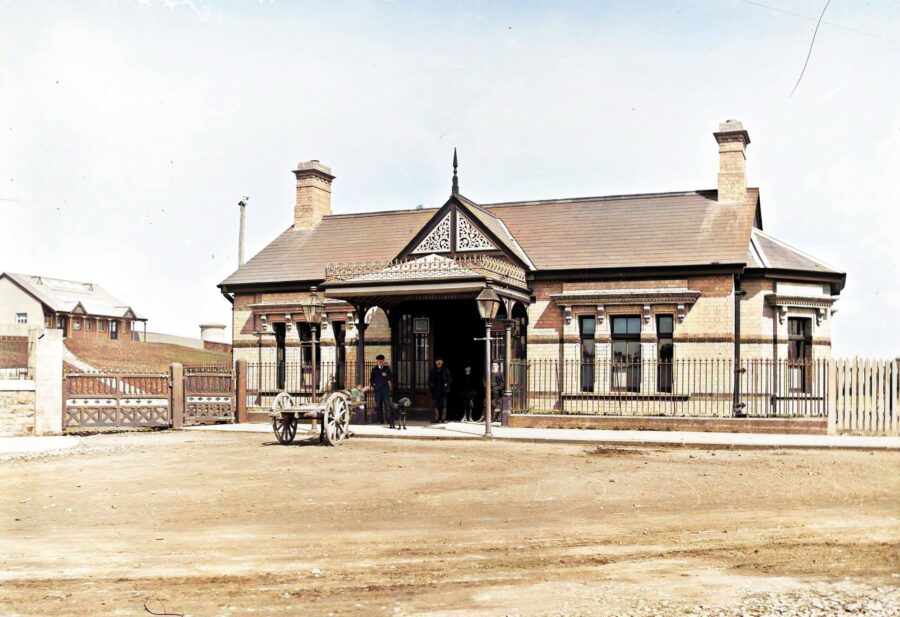
However, the partition of Ireland in 1922 complicated matters, as Bundoran’s rail link to the rest of the Irish Free State now passed through Northern Ireland, subjecting it to customs inspections. The railway line to Bundoran eventually closed in 1957 due to these complications and changing travel patterns.
Road developments:
As railway services declined, road infrastructure became increasingly important for Bundoran’s connectivity. Significant road developments include:
- Early coastal road: Around the mid-19th century, Colonel Conolly built the coastal road passing by Carricknanean and Thrupenny Pool, enhancing local connectivity.
- Improvements to main routes: Gradual improvements to the roads connecting Bundoran to major towns like Sligo and Ballyshannon enhanced accessibility for motorists.
- Bundoran/Ballyshannon bypass: Opened in April 2006, this major infrastructure project significantly improved access to Bundoran. The bypass made the resort more easily reachable, reducing travel times and congestion.
- N15 road: Improvements to this national secondary road, which passes near Bundoran, have further enhanced connectivity with other parts of Ireland.
- Wild Atlantic Way: While not a road development per se, the inclusion of Bundoran on this touring route has increased its visibility and accessibility to both domestic and international tourists traveling by road.
These road developments have helped Bundoran maintain its status as a popular tourist destination in the post-railway era. They have made the town more accessible to self-drive tourists and facilitated easier day trips from nearby urban centers.
Local Traditions and Culture
Bundoran’s rich cultural heritage is deeply rooted in Irish traditions, with Gaelic games and music playing significant roles in the town’s identity and social life. These cultural elements have not only entertained locals but also become attractions for visitors, adding depth to Bundoran’s appeal as a tourist destination.
Gaelic Games:
Gaelic games, particularly Gaelic football, have a strong presence in Bundoran’s sporting and cultural landscape:
- Early history: In the 1920s, Bundoran’s location on the railway line made its local ground a convenient venue for many important Gaelic Athletic Association (GAA) matches.
- Réalt na Mara GAA Club: The local GAA club, named “Réalt na Mara” (Star of the Sea), was reorganized under this name in the late 1930s. The club’s grounds were purchased in 1938, marking a significant milestone in the town’s sporting history.
- Development of facilities: The football park has undergone several improvements over the years. It was levelled in 1947, enclosed in 1951, and club changing rooms were constructed in 1972.
- Sporting achievements: The junior team saw success in both the 1956 and 1960 Championships. In 1979, Bundoran achieved a notable victory in the Senior Championship, beating Ballybofey by a single point.
- Contribution to county success: Several players from Bundoran have contributed to the Donegal county team. Most notably, local man Brian McEniff led Donegal to victory in the 1992 All-Ireland Senior Football Championship Final against Dublin, sparking enormous celebrations in Bundoran that lasted nearly a month.
- Recent success: In 2015, Réalt Na Mara won the Donegal Intermediate Football Championship title and reached the Ulster final, showcasing the continued strength of Gaelic games in the town.
Music and Festivals:
Music has long been an integral part of Bundoran’s culture, with the town hosting various musical events and fostering a vibrant music scene:
- Traditional music: Like many Irish towns, Bundoran has a strong tradition of Irish folk music, with sessions regularly held in local pubs.
- Dancehall era: The Astoria Ballroom, built in 1953, became a major venue for dances and concerts. It hosted popular showbands and large dances, playing a significant role in the social life of the town and surrounding areas.
- Modern music venues: Various pubs and hotels in Bundoran continue to host live music events, catering to a range of musical tastes.
- Sea Sessions Surf and Music Festival: Launched in the 21st century, this annual event has become one of Bundoran’s major attractions. Held every June, it combines music performances with surfing competitions, attracting thousands of visitors and putting Bundoran on the map for a younger generation of tourists.
- Other festivals: Bundoran hosts several other cultural events throughout the year, including:
- Bundoran’s Carnival Week: A traditional summer festival featuring parades, competitions, and family entertainment.
- Bundoran Lifeboat Soapbox Race: An annual charity event that combines creativity with community spirit.
- Bundoran Christmas Market: A relatively new addition to the town’s cultural calendar, enhancing Bundoran’s appeal as a year-round destination.
Musical heritage:
The town has connections to various musicians and bands. For example, the Screaming Orphans, a Celtic pop band, hail from Bundoran.
The combination of traditional Gaelic games and a diverse music scene contributes significantly to Bundoran’s cultural vibrancy. These elements not only provide entertainment and a sense of community for locals but also offer visitors authentic experiences of Irish culture. By maintaining these traditions while also embracing modern festivals and events, Bundoran continues to evolve its cultural offerings, ensuring its appeal to a wide range of visitors while staying true to its Irish heritage.
Bundoran Today
Current status as a tourist destination:
Bundoran has successfully maintained its status as one of Ireland’s premier seaside resorts, adapting to changing tourism trends while preserving its traditional charm. Key aspects of its current tourism profile include:
- Surf Capital of Ireland: Bundoran has firmly established itself as a major surfing destination. In 2012, National Geographic magazine listed it as one of the world’s top 20 surf towns, solidifying its international reputation.
- Year-round destination: While still popular for summer holidays, Bundoran has diversified its offerings to attract visitors throughout the year. The surf scene, indoor attractions like Waterworld, and various festivals contribute to this extended season.
- Adventure tourism: Beyond surfing, Bundoran caters to adventure seekers with activities like kayaking, stand-up paddleboarding, and coastal walks.
- Family-friendly attractions: Waterworld, amusement arcades, and beaches continue to make Bundoran appealing for family vacations.
- Golf tourism: The Bundoran Golf Club, with its scenic coastal location, remains a draw for golf enthusiasts.
- Music and festival scene: Events like the Sea Sessions Surf and Music Festival attract a younger demographic, helping to renew Bundoran’s visitor base.
- Wellness tourism: Traditional seaweed baths and modern spa facilities cater to visitors seeking relaxation and health benefits.
- Wild Atlantic Way: Bundoran’s inclusion on this scenic coastal route has increased its visibility to both domestic and international tourists.
Economic and social landscape:
Bundoran’s economy and social fabric remain closely tied to its identity as a tourist town, but with evolving challenges and opportunities:
- Tourism-dependent economy: The tourism sector continues to be the primary driver of Bundoran’s economy, providing employment in hospitality, retail, and service industries.
- Seasonal fluctuations: Despite efforts to extend the tourist season, the town still experiences significant seasonal variations in economic activity and employment.
- Property market: The popularity of Bundoran as a holiday destination has influenced its property market, with a significant number of holiday homes and rental properties. This can present challenges for local residents in terms of housing affordability and availability.
- Infrastructure development: Ongoing investments in infrastructure, such as the €500,000 allocated through Failte Ireland’s Destination Town initiative, aim to enhance the town’s appeal and facilities.
- Educational facilities: The presence of Magh Ene College, built on the former site of St. Joseph’s and St. Martha’s Orphanages, provides secondary education for local youth.
- Community initiatives: Various community groups and initiatives work to maintain Bundoran’s cultural heritage and improve quality of life for residents. These include efforts to maintain Blue Flag status for the main beach and organize community events.
- Environmental concerns: As a coastal town, Bundoran faces challenges related to climate change, including coastal erosion and more frequent storm events. There’s an increasing focus on sustainable tourism practices.
- Integration of permanent and seasonal populations: Bundoran must balance the needs and interests of its year-round residents with those of seasonal visitors and second-home owners.
- Digital nomad potential: With the rise of remote work, Bundoran has the potential to attract digital nomads seeking a high quality of life in a scenic location, possibly helping to smooth out some of the seasonal economic fluctuations.
- Cross-border dynamics: Bundoran’s proximity to the border with Northern Ireland means it’s affected by cross-border economic and social dynamics, including currency fluctuations and differing regulations.
Today, Bundoran stands as a town that has successfully leveraged its natural assets and cultural heritage to maintain its relevance in Ireland’s tourism landscape. While facing the challenges common to many seasonal resort towns, it continues to evolve, seeking ways to sustain its economy, support its local community, and preserve the unique character that has made it a beloved destination for generations of visitors.


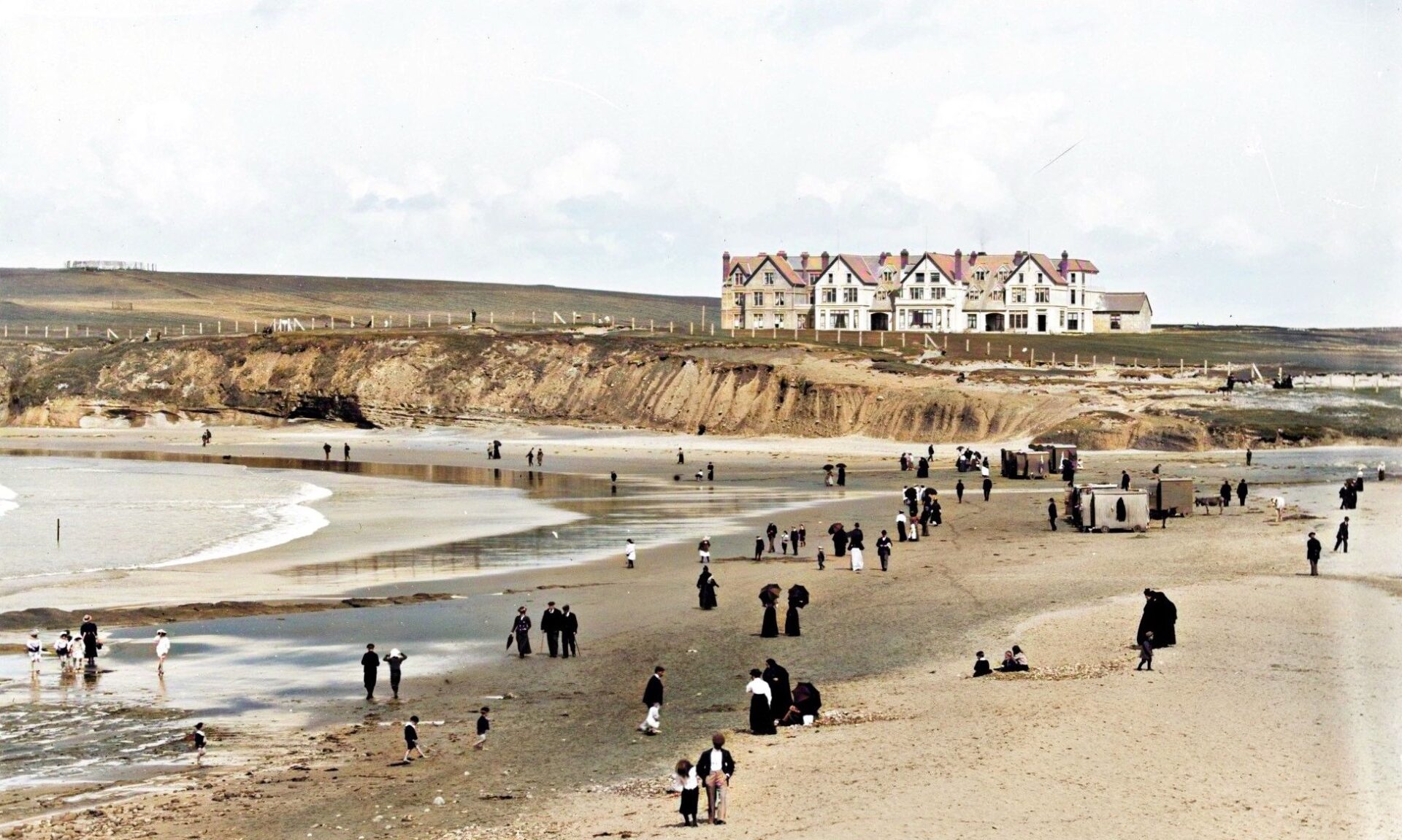
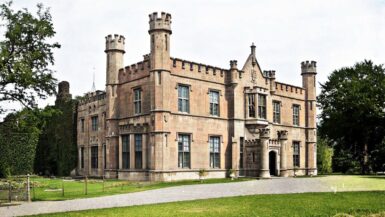
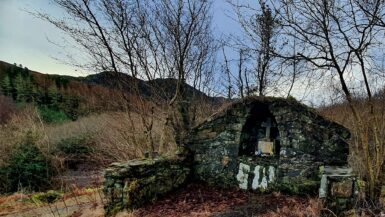
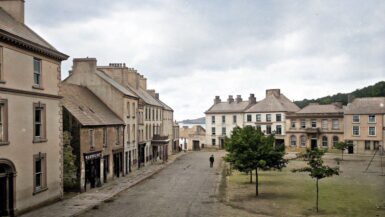
Leave a reply